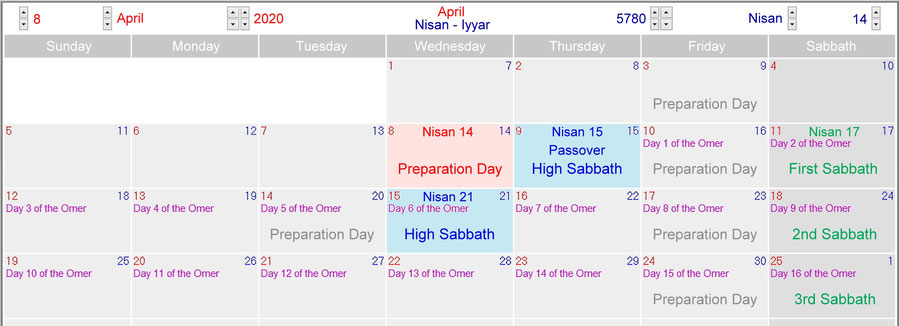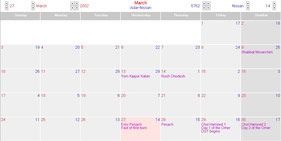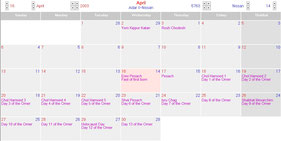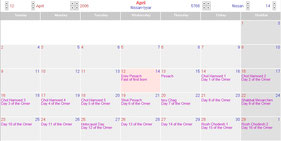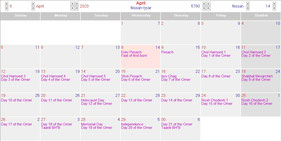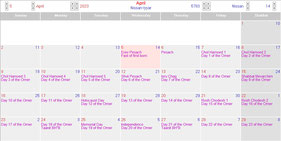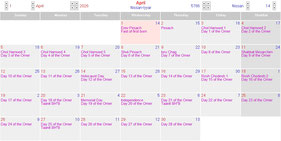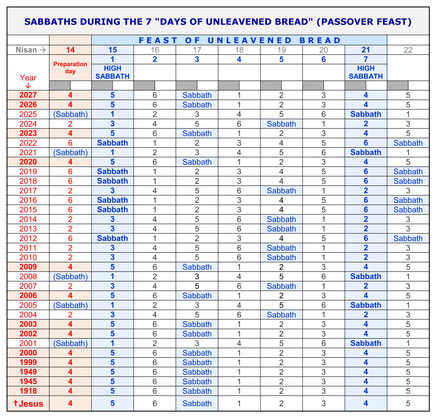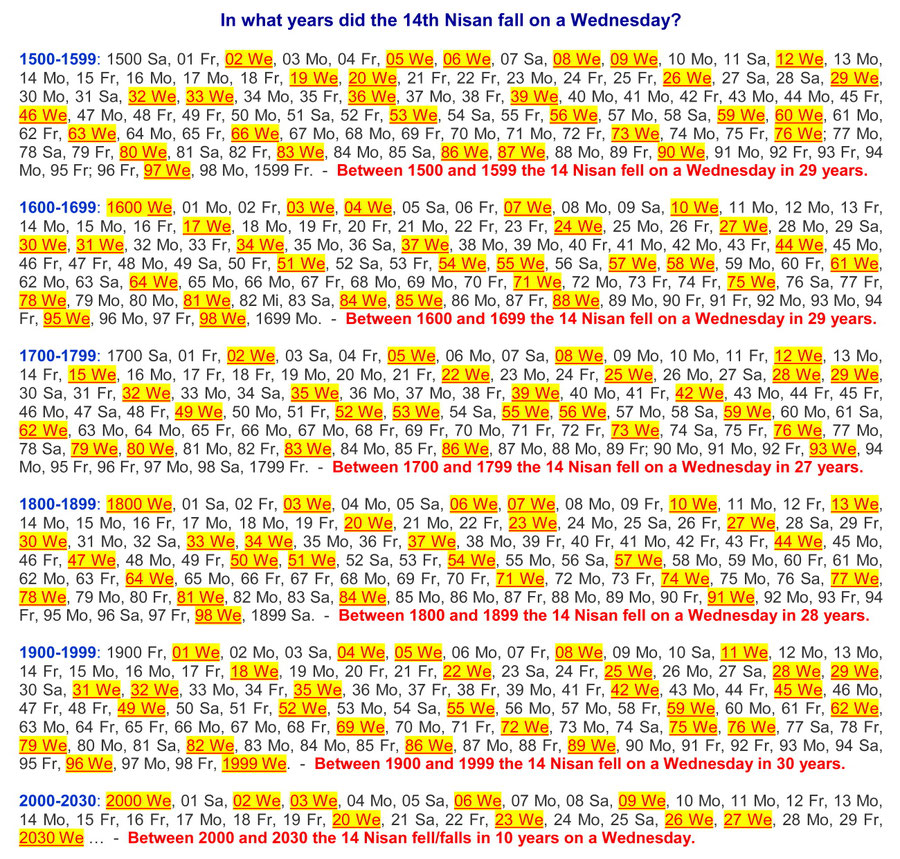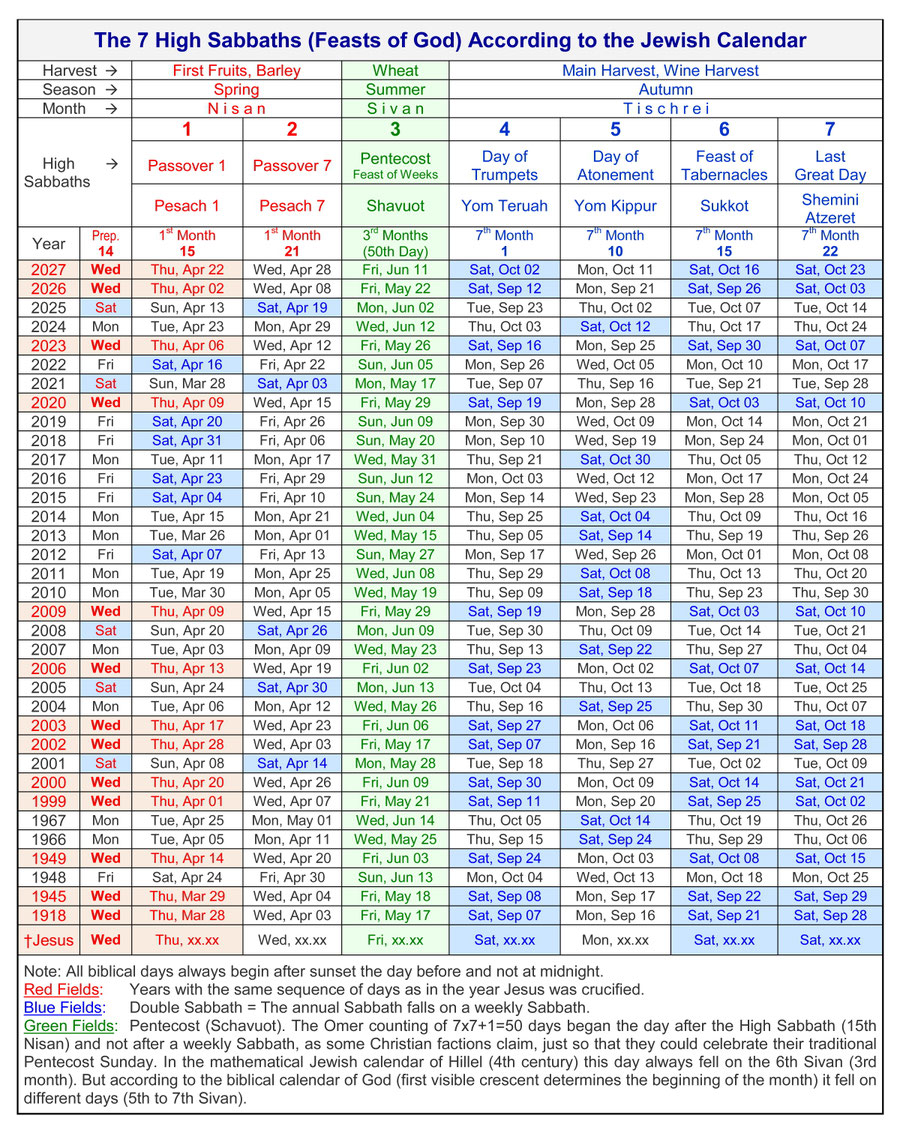- Home
- English
- Structure of the Bible
- Structure of the Menorah
- Ancient Menorahs
- Calendar and Feasts
- Resurrection on Sabbath
- Introduction
- Day
- Sabbath
- High Sabbath
- Pre-Sabbath
- Week
- Interlinear Bible
- Church Opinions
- 1. No Sunday
- 2. A Sabbath
- 3. No Friday
- 4. Intermediate Day
- 5. Three Days and Three Nights
- 6. Manipulations
- 6.1 Sabbath not Sunday
- 6.2 Plural σαββατων not week
- 6.3 one not first
- 6.5 Day of the Sabbaths
- 6.7 Lords Day
- 7. Old Bibles
- Greek Bibles
- Latin Bibles
- Gothic Bible
- English Manuscripts
- English Bible Prints 1
- English Bible Prints 2
- English Bible Prints 3
- English Bible Prints 4
- German Manuscripts
- German Bible Prints 1
- German Bible Prints 2
- Spanish Bibles
- Italian Bibles
- Swedish Bibles
- μια των σαββατων
- Mt 28-1
- Mk 16-2
- Mk 16-9
- Lk 24-1
- John 20-1
- John 20-19
- Acts 20-7
- 1Cor 16-2
- Lk 18-12
- 7 Languages
- Palm Sabbath
- Omer
- Summary
- The Rapture
- Rabbi Kaduri Note
- 666
- 888
- Video
- Info
- Francais
- Deutsch
- Espanol
- Dutch
- Ελληνική
- Pусский
- Introduction
- Day
- Sabbath
- High Sabbath
- Pre-Sabbath
- Week
- Interlinear Bible
- Church Opinions
- 1. No Sunday
- 2. A Sabbath
- 3. No Friday
- 4. Intermediate Day
- 5. Three Days and Three Nights
- 6. Manipulations
- 6.1 Sabbath not Sunday
- 6.2 Plural σαββατων not week
- 6.3 one not first
- 6.5 Day of the Sabbaths
- 6.7 Lords Day
- 7. Old Bibles
- Greek Bibles
- Latin Bibles
- Gothic Bible
- English Manuscripts
- English Bible Prints 1
- English Bible Prints 2
- English Bible Prints 3
- English Bible Prints 4
- German Manuscripts
- German Bible Prints 1
- German Bible Prints 2
- Spanish Bibles
- Italian Bibles
- Swedish Bibles
- μια των σαββατων
- Mt 28-1
- Mk 16-2
- Mk 16-9
- Lk 24-1
- John 20-1
- John 20-19
- Acts 20-7
- 1Cor 16-2
- Lk 18-12
- 7 Languages
- Palm Sabbath
- Omer
- Summary
4. The one day between the two Sabbaths
The 4th scientific proof that Jesus rose from the dead on a Sabbath morning: There is a clear biblical fact that the conventional opinion that Jesus was crucified on Good Friday and rose from the dead on Easter Sunday cannot be true at all. Between the burial of Jesus on the preparation day and His resurrection there is not only talk of one Sabbath, but of TWO. The mention of these two Sabbaths is a further valuable proof that Jesus could not have died on a preparation day for a double Sabbath, that is, not on a Friday. The biblical facts:
The women prepare the oils BEFORE and AFTER the Sabbath
An alleged contradiction arises when comparing the statements of Mk 16:1 and Lk 23:56. The evangelist Mark writes:
Mk 16:1: „When the Sabbath was past, [the women] ... bought spices, so that they might go and anoint him [Jesus].“
But Luke says that this event was not after the Sabbath, but before:
Luke 23:55-56: „Then they returned and prepared spices and ointments. 56b On the Sabbath they rested according to the commandment.“
According to Mark, the women clearly went shopping AFTER the Sabbath in order to prepare the ointments on the working day; but according to Luke, they prepared the ointments on the working day BEFORE the Sabbath in order to rest on the following Sabbath. This great alleged contradiction between Mark and Luke has caused many Bible readers headaches. For some, it has even been one of the greatest proofs of doubting the authority of the Bible and making fun of the Word of God. In almost all Bible-critical books this comparison is mentioned. It has even been claimed that the Bible contains clear errors and is therefore implausible. Here the solution is very simple, as long as Christians are familiar with the calendar of God. After the Sabbath is before the Sabbath, as there are not only one or two, but even three Sabbaths in the 7-day Passover week. And this even every year, although in some years a yearly Sabbath may fall on a weekly Sabbath. The evangelists clearly speak of TWO different Sabbaths that are close in time, with at least one weekday in between. They describe the preparation of ointments AFTER the yearly High Sabbath and BEFORE the weekly Sabbath:
It is obvious: the preparation day of the 14th Nisan in that week must correspond to our Wednesday today, which was followed by the High Sabbath (Thursday). Then followed a workday (Friday) and then the weekly Sabbath (Saturday). It is true that this working day before the weekly Sabbath in the New Testament is not expressly referred to as the "preparation day", but this is not necessary at all, because nothing is written about this day except that the women have prepared the ointments. It is also a quite normal preparation day, which appears every week in the year before a weekly Sabbath. The preparation day (14th Nisan) for Passover (15th Nisan, annual or high festival Sabbath) was much more important.
The possibility that the 14th Nisan (the day of Jesus' crucifixion) falls on a Wednesday is something absolutely normal according to the biblical calendar and has come and will come in about 30% of all years. This same constellation has already very often existed not only at the time of Jesus and the first Christian congregation, but throughout the history of humanity, and every person who is reading this text right now has experienced in his life several times exactly the same holiday sequence at the time of the Passover, as in the year in which Jesus was crucified. In the following years, according to the Jewish calendar, the 14th Nisan fell on a Wednesday: 1972, 1975, 1979, 1982, 1986, 1989, 1996, 1999, 2000, 2002, 2003, 2006, and 2009. In the future, too, the same Passover order will exist as at the time of Jesus, in 2020, 2023, 2026, 2027 and 2030 (see table below).
The women prepare the oils AFTER the Sabbath and come ON the Sabbath
Another alleged contradiction can be found in the gospel of Mark. Mark mentions that at the end of the preparation day (clearly before the Sabbath) the women "saw where he [Jesus] was laid" (Mark 15:47) and immediately afterwards he writes: "When the Sabbath was past, Mary Magdalene, Mary the mother of James, and Salome bought spices, so that they might go and anoint him" (Mark 16:1). And then immediately in the next verse (Mk 16:2) he emphasizes: "And very early on the first day of the week, when the sun had risen, they went to the tomb." Martin Luther writes that the women clearly bought the ingredients for the ointments AFTER (not before!) the Sabbath and then that they came to the tomb "ON a Sabbath". Luther's words also correspond to the literal translation from the basic Greek text, which many Bible experts around the world have also translated as correct (for examples see Old Bibles). Many English Bibles have also been correctly translated and speak of the coming of women to the tomb "on a Sabbath" or "on one of the Sabbaths."
"When the Sabbath was past" and "on a Sabbath". How is this possible? Is this not a contradiction? If the women went shopping AFTER the Sabbath, then they could not possibly have come to the tomb ON the Sabbath, as there would be a whole week in between. But Mark did not make a mistake. The explanation is very simple, because also here we are talking about two different Sabbaths: Jesus was buried on the preparation day (14th Nisan) for the feast Sabbath (15th Nisan) and the day after this High Sabbath the women went shopping to come to the grave on the following weekly Sabbath (17th Nisan). There are no contradictions. The explanation is so simple. Any child can understand it. Here again we are clearly talking about two Sabbaths, because at the time of Passover there are always three Sabbaths within a week. After the burial of Jesus at the end of the preparation day (14th Nisan), the women would never have been able to prepare the ointments, because there was not enough time for shopping and preparing the ointments. The women went home at the end of the preparation day and immediately the great Sabbath began. The women could not go shopping on the High Sabbath, since all trade, whether in the night or day phase, was strictly forbidden and thus not possible at all. Consequently, they prepared the ointments "after the Sabbath" and came "on a Sabbath" to the tomb. The two Sabbaths in a row, which some Seventh-day Adventists accept (see church opinions), are also not possible, since the women prepared the ointments "when the Sabbath was past" and Jesus could not otherwise have been in the tomb "three days and three nights", since at least one night would be missing. There must therefore have been a working day between the Sabbaths:
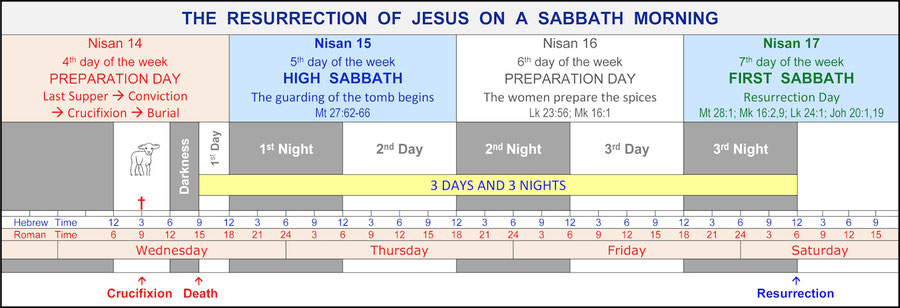
This working day between the two Sabbaths at the Passover celebration occurs statistically very frequently (about every third year). That there were two Sabbaths in the year in which Jesus was murdered was known to all Christians from the so-called "early church", since they all knew the calendar of God (calendar of Israel) since their childhood. It was only when more and more Gentile Christians were admitted to the congregation and the Christians were scattered all over the world that the knowledge of how to calculate the feast day was increasingly lost. But even today there are still Christians and Bible experts all over the world who confirm this fact of the two Sabbaths. An example:
- Jonathan Mitchell (JMNT 2009) on Lk 24,1: „The sabbath of 23:56, above, would have been the Day of passover; the sabbath of this verse would then been the seventh day of that week, or, the weekly sabbath.“
- Jonathan Mitchell (JMNT 2009) on Joh 20,1: „Passover was one sabbath, and the seventh day of the week was another sabbath.“
- Daniel Gregg (MISB 2011) on Mk 16:1: „This [i.e. buying the ointments] could not have been done on a Sabbath or a feast day. See Nehemiah 10:31. The spices had to be bought between the feastival Sabbath (Nisan 15) and the weekly Sabbath (Nisan 17), which that year was a Friday.“
Three Sabbaths within seven days!
Only a year can be considered in which two Sabbaths were separated by one working day. The 15th Nisan was the first Sabbath of the year, and the 17th Nisan was the first weekly Sabbath of a series of seven weekly Sabbaths between Passover and Pentecost. The intervening second annual Sabbath on the 21st Nisan played no role in the calculation of the 50th day. Since there are 3 Sabbaths in the Passover week, there must therefore also be 3 days of preparation for the Sabbath:

Every Christian can easily convince himself of the three Sabbaths during the Passover feast by looking at the Jewish calendar, which is often offered free of charge on the Internet, such as on the Hebcal or Hagalil website or from the Kaluach program, from which the following illustration (slightly modified) dates from the year 2020:
The following illustrations show some years from the Jewish calendar in which the 14th Nisan fell on a Wednesday, the 15th Nisan on a Thursday and the 17th Nisan on a weekly Sabbath. There is always a weekday between the two Sabbaths:
An arrogant attitude closes the doors to understanding the Bible
The NT is very easy to understand in the resurrection chapter. Why do so many Christians know nothing about the crucifixion of Jesus on a Wednesday and His resurrection on the Sabbath? Because many priests and pastors neglect the Old Testament (OT; although it was initially for decades the only written basis of the first Christian church and was quoted very often by Jesus and the apostles), it is impossible for them to understand the New Testament statement about the sequence of days after the burial of Jesus.
Many Christians say "I do not need the OT, only the NT is important to me". But in doing so, they ignore most of the Word of God and reject the foundation for understanding the NT. Because of this arrogant attitude, translation errors are inevitable. They reap what they sow. Therefore, the door to understanding the Bible is closed for them. They are blind and do not even know what was clear even to children at the time of the first Christian church, namely that the women came to the tomb "on one of the Sabbaths" of the Passover feast or "on the first Sabbath", the first of the 7 Sabbaths between Passover and Pentecost.
In other words: If Christian churches set aside the Old Testament and the calendar described therein with the calculation of the biblical feast days, they miss out on important basic knowledge for understanding the New Testament and God's plan. Senseless theological disputes, incorrect Bible translations, interpretations and seductions must inevitably be the result of this arrogant attitude.
The calendar of God and the "days of unleavened bread"
The following table shows the arrangement of the three Sabbaths during the "seven days of unleavened bread" (15th-21st Nisan) according to the Jewish calendar from 1999 to 2027. The evangelists spoke of several Sabbaths. In the years 1999 to 2027 there are 10 times the same sequence of days on Passover as in the year of Jesus' crucifixion (areas marked in red). Jesus really rose from the dead "after three days and three nights" (Mt 12:38-40). He has not lied to us. Even in the years in which the First and Second World Wars (1918 and 1945) ended, there was the same order of days as in the year of Jesus' death. There were also always years in which the preparation day (14th Nisan) fell on a weekly Sabbath. In this case the Israelites were obliged to remove all leavened bread from their houses the day before, because this work was not allowed to be done on the Sabbath. If the 14th Nisan fell on a weekly Sabbath, the day before that was of course considered a preparation day, but never the Sabbath. It should be noted here that the biblical day begins and ends after sunset, that is, already in the evening of the preceding calendar days. The Roman Catholic day, on the other hand, begins at midnight (midnight) and therefore contains parts of two biblical days.
Jesus must have died on a Wednesday (fourth day of the week) because (as already proved) there must be a working day between the High Sabbath and the weekly Sabbath. Jesus died on the 14th Nisan (Wednesday) and was resurrected after "three days and three nights" "on a Sabbath" (17th Nisan), There is no contradiction between what the Bible says and the holiday calendar.
This table also clearly shows that the 14th Nisan very often falls on a Wednesday. There is often the same weekday sequence as in the year of Jesus' crucifixion. In the coming year 2023 every person can experience this sequence again. In some years the annual Sabbath falls on a weekly Sabbath, then a so-called "double Sabbath" (see Sabbath). The first Sabbath of the seven Sabbaths until Pentecost always falls on the 17th Nisan, when the 14th Nisan falls on a Wednesday. Knowledge of the biblical sequence of days on the Passover holidays opens the key to understanding the statements of the evangelists.
There are several programs that allow you to calculate backwards and forwards the Jewish calendar days and thus show the biblical festivals. However, caution is advised, because according to this sources, only the data of the last centuries are correct, but for the years that come into question the date of Jesus' crucifixion, the data are not correct, because they are only theoretically interpolated by the program and in some programs they differ from each other. Furthermore, there are differences between the biblical and the Jewish calendar. The Jewish calendar is a mathematical calendar where the beginning of the month does not always begin at the time of the first possible sighting of the new light (first visible appearance of the crescent moon). But the calendar of God (the biblical calendar) is an astronomical calendar where each month begins with the new light (see calendar). Therefore, astronomical dates (first visible crescent moon) must be used to help calculate the holidays at the time of Jesus. The lower dates of the years 1500 to 2030 in the Jewish calendar show that statistically the 14th Nisan falls on a Wednesday every three years (underlined and marked yellow):
The phrase "on one of the Sabbaths" is understood by every child
As has been clearly shown, there are THREE Sabbaths in a Passover week of 7 days. After the Sabbath is before the Sabbath. The basic Greek text in Luke 24:1 is very easy to understand with this background knowledge:
"τη (on the) δε (but) μια (one) των (of the) σαββατων (Sabbaths) ορθρου (darkness) βαθεως (deeper)... (they came to the tomb)..."
In English this passage should read: "But on one of the Sabbaths (or sabbath days), during deep darkness, they came to the tomb." Also Martin Luther translated this verse correctly 500 years ago: "but on a sabbath a very early they came to the tomb" („aber an der Sabbate einem sehr frühe kamen sie zum Grabe“; LUT 1545). This is a clear and unmistakable statement that every Christian understands. Even the Concordant Literal Translation (CLV) does not distort the meaning of Luke and has been spreading this message since before the Second World War. So this is not a new knowledge, but not a message that Christians want to hear, so they prefer to use translations that correspond to their Sunday wishes, but not the literal Sabbath words of God:
CLV: "Now in the early depths of one of the sabbaths, they, and certain others together with them, came to the tomb..."
So we are talking here of several Sabbaths, not of a double Sabbath. But also the translation "on a Sabbath" (instead of "on one of the Sabbaths") is of course correct, since it is a matter of a certain Sabbath day. Strictly speaking, this was the first Sabbath of the seven weekly Sabbaths between Passover and Pentecost, as Mark (Mark 16:9) emphasizes literally: "early first Sabbath" in the singular genitive, it could not be clearer.
Why did the women prepare the ointments?
The NT reports that Jesus was already laid in anointed cloths before the burial, according to Jewish tradition:
John 19:39-40: "Nicodemus also, who earlier had come to Jesus[e] by night, came bringing a mixture of myrrh and aloes, about seventy-five pounds[f] in weight. 40 So they took the body of Jesus and bound it in linen cloths with the spices, as is the burial custom of the Jews."
However, an intensive embalming of the dead was not common in Israel and was only carried out in exceptional cases. In the Old Testament this was only done in the case of Jacob and Joseph (Gen 50:2,26), and this in connection with transport from Egypt, because the bodies had to be carried over a long distance to the place of burial, were not allowed to stink, and because the Egyptians were experts in embalming. Jesus was a special case because he was the King of the Jews. As John tells us, Jesus was already placed in anointed linen cloths shortly before the burial. The wrapping in pre-prepared cloths, which was quickly carried out on the day of the preparation, was only meant to delay the process of decay until a thorough embalming could only take place "after 3 days and 3 nights" (Mt 12:38-40). At an earlier point in time this would be absolutely impossible:
- because the High Sabbath (15th Nisan) followed the preparation day, when all work was forbidden, and
- because Jesus' grave was sealed and was strictly guarded by Roman soldiers until the end of the third day (Mt 27:62-66).
Opening the grave earlier would result in the death penalty. The earliest possible time to anoint Jesus would be after these "3 days and 3 nights", i.e. exactly at the dawn on an ordinary weekly Sabbath, when the tomb was to be opened. This was supposed to show the world that Jesus was still in the tomb and had not fulfilled the Messiah sign. But it turned out quite differently, because God himself opened the grave.
Why did the women prepare the oils and come on a Sabbath?
An important question is appropriate: Why did the women prepare the oils and ointments? Was this not superfluous? Were they not aware that Jesus would rise from the dead? Didn't you know that many generations before, in the Psalms (Ps 16:10; Acts 2:27,31; 13:34-37), it was prophesied about Jesus that his body would not see decay? Did the women not believe in the resurrection of Jesus, so that they wanted to delay the decomposition of his body by anointing it? These are legitimate questions. The fact is: We cannot find a single person in the entire New Testament who was truly convinced of the resurrection of Jesus. Although it was the hope of the people, this idea was so incredible and so sensational that nobody could really imagine what it actually meant. If the women had really believed in the announced resurrection of their Lord, they would have gone to the tomb not with ointments but with flowers, cakes and wine to celebrate the reunion with Jesus. We do not find a single person in the New Testament who would have said cheerful and encouraging words to Mary and the other women, such as:
"Jesus has paid the death penalty for us, he will live soon and you can save the money for the ointments, because Jesus will rise anyway after 3 days and 3 nights and his body will not decay"
No, instead the disciples were full of fear and uncertainty. Although they could imagine that Jesus would rise spiritually and perhaps thought that this would be like Lazarus on Judgment Day (Jn 6:40; 11:24), but that his dead body "after 3 days and 3 nights" would again look like before, nobody could really imagine that. John confirms this with the words:
"for as yet they [the women and the apostles] did not understand the Scripture, that he [Jesus] must rise from the dead" (Jn 20:9).
That is why they went to the tomb with the ointments. Both Mary, the mother of Jesus, and all the disciples were very disappointed after Jesus died in this way. No one was full of joy in the certainty that the resurrection of Jesus was imminent, but all were deeply desperate, powerless, sad, frustrated, perplexed and unbelieving.
Even when Jesus appeared to several people after his death, some still did not believe it and Thomas only believed after he himself was able to touch the wounds of Jesus (Jn 20:24-29). People could only fully grasp the miracle of the resurrection when they saw Jesus personally and when He was with them for another 40 days. Only after that and especially when the Holy Spirit was poured out at Pentecost could they believe and understand it.
It was no sin to anoint dead people on a Sabbath
The embalming of the dead on a small weekly Sabbath was not prohibited in Israel in certain situations. It was allowed because death does not stop before a Sabbath. There was also an exceptional situation here, because the women were not allowed to come to the tomb earlier because of the Roman guards and they had to wait until the third day was over. If they had waited an extra day, that is, until after the Sabbath, the process of decomposition would have been too advanced after four days because of the higher temperatures in Israel. This work would then be really scary, because four days is a very long time if there is no real cooling (Passover is in spring at the time of the first grain harvest).
Sick people were allowed to be healed on the Sabbath
Jesus Himself has answered all these questions. On the Sabbath, various works were allowed to be done to heal the sick (Mt 12:9-14; Mk 3:1-6; Lk 6:6-11). Everyone who works in a hospital or old people's home knows how hard the work can be even on the Sabbath and you can't just close the hospital or old people's home for a day and tell people "today is the Sabbath, you must suffer and die because we are not allowed to work". No, certainly not. Even today some Israelites in hospitals, in old people's homes, in the police and in the military sometimes have to work hard without being guilty of breaking the Sabbath.
Jesus Himself ordered a sick person to carry His heavy bed on the Sabbath (Jn 5:8-18). For the priests, this was a clear breaking of the Sabbath (v. 18), but Jesus was concerned about the man, because "mercy triumphs over judgment" (James 2:13). If Jesus allows a bed to be carried on the Sabbath, why should women not be allowed to carry ointments that weigh much less? Jesus even allowed the harvesting of ears of corn in the field when people were hungry (Mt 12:1-8). The priests also had to work on the Sabbath to perform the ceremonies. Therefore, Jesus said that "on the Sabbath the priests in the temple profane [break, violate] the Sabbath and are guiltless" (Mt 12:5-6):
Mt 12:1-6. “At that time Jesus went through the grainfields on the Sabbath. His disciples were hungry, and they began to pluck heads of grain and to eat. 2 But when the Pharisees saw it, they said to him, “Look, your disciples are doing what is not lawful to do on the Sabbath.” 3 He said to them, “Have you not read what David did when he was hungry, and those who were with him: 4 how he entered the house of God and ate the bread of the Presence, which it was not lawful for him to eat nor for those who were with him, but only for the priests? 5 Or have you not read in the Law how on the Sabbath the priests in the temple profane the Sabbath and are guiltless? 6 I tell you, something greater than the temple is here.”
Yes, Jesus is much more important than the temple. So Jesus has indirectly answered the question concerning His embalming on a sabbath Himself in various bible passages.
Animals were allowed to be cared for on the Sabbath and even freed from pits
If even a donkey and an ox were allowed to be led out of its dirty stall to a watering place on the Sabbath (Lk 13:15), if a heavy sheep (lamb) was allowed to be taken out of a dirty earth pit on the Sabbath (Mt 12:11), and if even an ox was allowed to be taken out of a well, which is heavy labor for several men (Lk 14:5-6), then why should it not be allowed to anoint a loved one (the Lamb of God) on the Sabbath? Jesus said:
- Lk 13:14-17: „But the ruler of the synagogue, indignant because Jesus had healed on the Sabbath, said to the people, “There are six days in which work ought to be done. Come on those days and be healed, and not on the Sabbath day.” 15 Then the Lord answered him, “You hypocrites! Does not each of you on the Sabbath untie his ox or his donkey from the manger and lead it away to water it? 16 And ought not this woman, a daughter of Abraham whom Satan bound for eighteen years, be loosed from this bond on the Sabbath day?” 17 As he said these things, all his adversaries were put to shame, and all the people rejoiced at all the glorious things that were done by him.“
- Lk 14:5: „And he [Jesus] said to them, “Which of you, having a son [some manuscripts: a donkey] or an ox that has fallen into a well on a Sabbath day, will not immediately pull him out?” 6 And they could not reply to these things.“
- Mt 12:1-12: „And a man was there with a withered hand. And they asked him, “Is it lawful to heal on the Sabbath?” - so that they might accuse him. 11 He said to them, “Which one of you who has a sheep, if it falls into a pit on the Sabbath, will not take hold of it and lift it out? 12 Of how much more value is a man than a sheep! So it is lawful to do good on the Sabbath.“
Of course, was it a good thing to anoint the beloved Lord Jesus on the Sabbath, or should it be something bad and reprehensible to anoint the only person without sin on the Sabbath? The embalming on a small Sabbath (weekly Sabbath) was not prohibited. It was allowed because death does not stop before the Sabbath. Jesus called people hypocrites who set up self-righteous Sabbath rules and do not want to do acts of love. And if work is allowed to be done to liberate people and animals, why is the most important person in history not allowed to be anointed and his body to decompose instead? Wouldn't Jesus call these people hypocrites who put heavy labor on donkeys, sheep, and oxen before a simple anointing of Jesus? We would definitely anoint Jesus' body also on the Sabbath (the women could not come earlier because of the guard) and would not let His body decompose also the complete 4th day.
Some Christians have a terrible attitude, they want to erase the 7 times mentioned biblical resurrection Sabbath by the absurd argument that the women were allegedly not allowed to go to the grave on a normal weekly Sabbath (it was not a High Sabbath). As we have seen, some dirty work was allowed on the Sabbath, such as feeding/watering animals, milking cows and goats and freeing donkeys and sheep from a dirty pit (especially unpleasant when it rains); but the anointing of the Son of God, the only man without sin, this is said to have been forbidden? Is Jesus not much more than an animal? Should Jesus' body rot for another 24 hours, so that the women should only come to the grave after 4 days? What is this unloving attitude towards Jesus, with which some Christians try to bring the pagan Sunday into the Bible, to replace the calendar of God with the calendar of the Pope and to deny the sign of the Messiah (3 days and 3 nights)? Because of such a theory, clear biblical verses are ignored or twisted just to turn a Sabbath into a Sunday. And these people then talk about supposedly loving Jesus? No, they do not love Jesus. It was not a sin that the women went to the grave on the Sabbath, but quite the opposite, it was a commandment of humanity and love for Jesus.
The lambs were allowed to be slaughtered and prepared on the Sabbath (14 Nisan)
How much Christians embarrass themselves with their self-righteous arguments can be seen especially in the law for the slaughter of the lambs on the 14th of Nisan. The lamb had to be slaughtered on this day, even if the 14th of Nisan fell on a Sabbath (see evidence), which is, however, rarely the case in God's calendar. This means that it is allowed to kill a lamb on the Sabbath, to pull the skin over its ears and to roast it with fire; but to anoint the dead Lord Jesus Christ (the most important man on earth), this is supposed to be forbidden? Is not our Lord much more than an animal? This shows the loveless and self-righteous attitude of many Christians who do not recognize the spiritual meaning of a law. They would rather just let the body of their Lord lie in the grave and decompose, just to say that they keep the Sabbath. No, there is a far higher commandment here before the commandment of Sabbath rest, namely the law of love. The ignorance of many Christians in biblical understanding is revealed by their embarrassing argumentation. And with such hypocritical embarrassing Sabbath rest arguments they want to replace the biblical Sabbath with the unbiblical Sunday?
Most Christians rarely read the Old Testament, even though it was the spiritual foundation of Jesus and the first Christian church. Therefore, they do not know that the Hebrews also had to sacrifice lambs as burnt offerings on all the Sabbaths and even twice as many on the Sabbath as on the weekdays (Num 28:1-10). That was over 200 lambs that had to be presented as burnt offerings on the Sabbaths during the year. This was heavy labor for the priests and for those who had to help them. In contrast, the anointing of a human being involved much less work, especially since the ointments were completed the day before. Here it must also not be overlooked, it was not about just any human being, but about the true and only Messiah who saved us all from eternal death. And some Christians want to let this Messiah simply lie in the grave and decompose, but at the same time they have nothing against heavy labor being performed on animals? What kind of self-righteous hypocrisy is this? Some Christians are worse than the Pharisees, because at least they knew that doing this was allowed on the Sabbath (even pulling the skin over the ears of a lamb on the Sabbath, the 14th of Nisan). Moreover, the Day of Resurrection is even about a small weekly Sabbath, not even about the High annual Sabbath with special regulations. For even on the High Sabbath lambs had to be offered as burnt offerings. See the chapter:
The slaughter of the Passover lambs on the Sabbath, the 14th of Nisan.
Jesus rode on a donkey on a sabbath day
Matthew (Mt 21:1-11) and John (Jn 12:12-16) make it clear that Jesus entered Jerusalem on a donkey on Nisan 10. In that year, the 10th of Nisan fell on a Sabbath (Palm Sabbath) because the 14th of Nisan fell on a Wednesday and the 17th of Nisan (Day of Resurrection) fell on the first Sabbath. According to the law, animals also had to rest on a Sabbath, but there were exceptional situations, for example, when people had to move to Jerusalem for the feast days established by law. Travel was avoided as much as possible, but short distances have always been no problem on a Sabbath. The entry of Jesus into Jerusalem was already predicted in Zechariah 9:9. It happens very often that the 10th of Nisan (the day of the separation of the Lamb) falls on a Sabbath, this is the case about every third year according to the biblical calendar.
Circumcisions were allowed to be made on the Sabbath
What many Christians are not aware of: even male babies were circumcised on the Sabbath and sick people were allowed to be healed. Why then should the beloved deceased simply be left behind?
John 7:22-24: "Moses gave you circumcision (not that it is from Moses, but from the fathers), and you circumcise a man on the Sabbath. 23 If on the Sabbath a man receives circumcision, so that the law of Moses may not be broken, are you angry with me because on the Sabbath I made a man's whole body well? 24 Do not judge by appearances, but judge with right judgment.”
This was exactly the problem of the Pharisees and is the problem of many Christian pastors today, who argue just like the Pharisees and do not judge justly. If the dead were to be left to themselves and decompose, then a much greater commandment would be broken, namely the commandment of love. Everyone who has a beloved deceased relative takes care of him or her after death, because the process of decay does not stop on a Sabbath. Just as babies had to be circumcised on a Sabbath so that the law would not be broken, so also sick and dead people had to be cared for on a Sabbath. This is the eternal commandment of love.
Jesus worked on the Sabbath to practice healings
Jesus gave an additional example when He himself worked on a Sabbath day, made a mud out of earth and got his hands dirty and he anointed a sick person on the Sabbath. Why is Jesus allowed to anoint other people with a paste on the Sabbath and why are other people not allowed to anoint Him with a paste? He gave an example of His coming anointing, which was to follow after His death on the Sabbath, but which was no longer necessary because He had already risen:
John 9:6-33: Jesus "spit on the ground and made mud with the saliva. Then he anointed the man's eyes with the mud 7 and said to him, “Go, wash in the pool of Siloam” (which means Sent). So he went and washed and came back seeing…10 So they said to him, “Then how were your eyes opened?” 11 He answered, “The man called Jesus made mud and anointed my eyes and said to me, ‘Go to Siloam and wash.’ So I went and washed and received my sight.” 12 They said to him, “Where is he?” He said, “I do not know.” 13 They brought to the Pharisees the man who had formerly been blind. 14 Now it was a Sabbath day when Jesus made the mud and opened his eyes. 15 So the Pharisees again asked him how he had received his sight. And he said to them, “He put mud on my eyes, and I washed, and I see.” 16 Some of the Pharisees said, “This man is not from God, for he does not keep the Sabbath.” But others said, “How can a man who is a sinner do such signs?” And there was a division among them... 24 So for the second time they called the man who had been blind and said to him, “Give glory to God. We know that this man [Jesus] is a sinner.” 25 He answered, “Whether he is a sinner I do not know. One thing I do know, that though I was blind, now I see.”... 30 The man answered, “Why, this is an amazing thing! You do not know where he comes from, and yet he opened my eyes. 31 We know that God does not listen to sinners, but if anyone is a worshiper of God and does his will, God listens to him. 32 Never since the world began has it been heard that anyone opened the eyes of a man born blind. 33 If this man were not from God, he could do nothing."
Here is to be considered: There was no hurry with the patient. Jesus could also have said "I will come after sunset, when the Sabbath is over" or "I will come tomorrow". So he would have no problems with the priests. But Jesus' aim was to show the true meaning of the Sabbath and to prepare for his coming anointing. On the contrary, the women were in great hurry, they could not wait because of the opening of the tomb and because of the process of decomposition.
For the Pharisees, Jesus was a sinner who broke the Sabbath (v.16). In their view, Jesus did something that the Torah does not allow. For this they wanted to punish him. It is important to note the following: Jesus could have healed the blind man completely without ointment, just as He healed other blind men by His Word alone and even raised the dead to life. Thus the sick man would not have had to go to the pool on a Sabbath, but could have rested. If it was at all necessary in symbolism, some water in the vicinity would have been enough. The mud of earth certainly did not heal the blind man, but it was the power of God. Why did Jesus make it so complicated? It was a symbolic act with a message to the whole world. Jesus wanted to show his disciples and the women in advance that the making of a mud (this means to work), the anointing (treatment of the sick or the dead) and even going to a certain place on the Sabbath is allowed. This event was a foreshadowing of the coming actions of the women at the tomb, so that no one could condemn them. Jesus prepared the mud on the Sabbath (he worked). In contrast, the women had finished the ointments even BEFORE the Sabbath, they rested on the Sabbath (from sunset; Lk 23:56) and went to the tomb in the morning with the finished vessels. Consequently, they worked even less on the Sabbath than Jesus himself.
The Sabbath commandment does not replace the resurrection Sabbath
The Bible reports seven times that the women came to the tomb in the morning "on one of the Sabbaths" (Mk 16:2; Lk 24:1; Jn 20:1) and "early on the first Sabbath" (Mk 16:9). Why should they have waited another day until Sunday and let Jesus' dead body decompose for four days? They had no problem with the Sabbath, for Jesus himself taught them all that doing good on the Sabbath was permitted (Mt 12:12). Or does anyone today claim that the women wanted to do something bad? What Torah law forbids this? Can anyone show this? And what Torah law forbids treating the sick and the dead on the Sabbath, and that police, doctors, firemen, and soldiers must all rest? No one can find such a law in the Torah, because they are meaningless prohibitions and misinterpretations of the Bible, thought up by self-righteous people. Those who condemn women today would certainly have condemned Jesus if they had lived in His time, because He made the mud on the Sabbath (He worked), "He anointed the man's eyes" (Jn 9:6) and He sent the man to the pool. The theologians who think up new and so far non-existent Torah commandments are the same people who also want to erase the Resurrection Sabbath from the Bible and replace it by Sunday. Therefore they invent new Torah commandments to prove that the women were allegedly not allowed to come to the tomb.
Besides, there was a great exception here, because the women were not allowed to come to the tomb earlier because of the Roman guarding and had to wait until the end of the 3rd day. They absolutely had to go to the tomb on a Sabbath morning, because after "3 days and 3 nights" it was the day when the Roman soldiers were supposed to finish the grave guard. The women came neither too early nor too late. They did not come on a Sunday morning, because they had been at the tomb exactly 24 hours before. Only this is what is written in the original Greek Bible and in many correct translations worldwide. If they had waited an extra day, that is, until after the Sabbath, the process of decomposition would have been too advanced after 4 days because of the higher temperatures in Israel. This work would then be really scary, because 4 days is a very long time if there is no cooling. See Lazurus when on the 4th day it was said "there will be an odor" (Jn 11:39).
John 11:38-40: "Then Jesus, deeply moved again, came to the tomb. It was a cave, and a stone lay against it. 39 Jesus said, “Take away the stone.” Martha, the sister of the dead man, said to him, “Lord, by this time there will be an odor, for he has been dead four days.” 40 Jesus said to her, “Did I not tell you that if you believed you would see the glory of God?”
Many Christians overlook this Bible passage and don't pay attention to what Jesus wanted to tell us all. In the case of Lazarus there was a cave in the rock with a stone in front of it, just as in the case of the tomb of Jesus. This example with the resurrection of Lazarus on the fourth day is not a coincidence, because it shows how important it was that the women came to the tomb of Jesus already on the weekly Sabbath and did not wait another day so that there would be no terrible odor.
If even donkeys and oxen were allowed to be watered on a Sabbath and sheep were allowed to be freed from the dirty pit, why should the anointing of the Savior of the world (the Lamb of God) be forbidden? This meaningless and unbiblical prohibition rule is only established by people who absolutely want to postpone the Resurrection Day and want to see Sunday in the Bible. They should travel to Israel and visit a hospital, nursing home, the police, the fire brigade or the military on a Sabbath day and see for themselves what needs to be done on the Sabbaths without being guilty. However, if the women had touched the dead body of Jesus during the anointing, they would be unclean until the evening, but it would not be a sin. However, since they did not touch it in the first place, all these discussions regarding the Torah and the Law are superfluous.
What is much more important: The elimination of the word "Sabbath" (in singular and plural) from the Bible and its replacement (addition to the Bible) by the pagan Sunday is a thousand times greater sin than the anointing of the Savior of the world on a Sabbath day (which is not a sin). See the warnings in Rev 22:18-19; Dt 4:2; Mt 18:6-7 and Luke 17:1-2. Millions of children of God have been deceived because some theologians wished for Sunday in the Bible, which no one has been able to find in the basic Greek text of the Bible for 2,000 years. What is worse, to anoint our Lord Jesus on a Sabbath or to seduce Christianity on a Sabbath and steal the Sabbath mentioned exactly 70 times (7x10=70, number of completeness) in the New Testament in the singular and plural in some verses from the Bible (=the Word of God) in order to pervert the statements of God?
To get back to our topic: The required ointments could only be bought and produced after the High Sabbath (15th Nisan), which means on the 16th Nisan. That was the day between the two Sabbaths, the "intermediate day". It was the day between the annual Sabbath (15th Nisan) and the weekly Sabbath (17th Nisan), the "first Sabbath" (Mk 16:9) of the seven weekly Sabbats between Passover and Pentecost:

There never was a turbo resurrection of Jesus that many theologians wanted, but rather He fulfilled the important sign of the Messiah (3 days and 3 nights).
The apocryphal Gospel of Peter confirms the Intermediate Day
The so-called "Gospel of Peter" is an apocryphal (i.e. not part of the Bible) writing from the 2nd century, which states that Jesus was resurrected "on the Lord's Day" (verse 50), but it is extremely interesting that it speaks of several Sabbaths in one week. Even the order of the days is correct:
[4-5] „And Pilate, having sent to Herod, requested his [Jesus] body. 5 „And Herod said: 'Brother Pilate, even if no one had requested him, we would have buried him, since indeed Sabbath is dawning. For in the Law it has been written: The sun is not to set on one put to death.' And he gave him over to the people before the first day of their feast of the Unleavened Bread.”
The handing over and crucifixion therefore clearly took place on the 14th of Nisan, the day before the High Feast Sabbath (always the 15th of Nisan). After the burial, the disciples fasted „night and day until the Sabbath”. Which Sabbath could this be referring to? Only the 17th of Nisan, of course, because there must be a working day between the High Sabbath and the Low Sabbath. It says literally from verse 24:
[24-27]: „And having taken the Lord, he [Joseph] washed and tied him with a linen cloth and brought him into his own sepulcher, called the Garden of Joseph. 25 Then the Jews and the elders and the priests, having come to know how much wrong they had done themselves, began to beat themselves and say: 'Woe to our sins. The judgment has approached and the end of Jerusalem.' 26 But I with the companions was sorrowful; and having been wounded in spirit, we were in hiding, for we were sought after by them as wrongdoers and as wishing to set fire to the sanctuary. 27 In addition to all these things we were fasting; and we were sitting mourning and weeping night and day until the Sabbath.”
Literally: νυκτὸϛ [night] καὶ [and] ἡμέραϛ [day] ἕωϛ [until; not "on"] τοῦ [the] σαββάτου [Sabbath]. Note: some translations say „day and night” because it sounds more logical to the translator, but in the Greek text the night is mentioned first, then the day.
After Jesus was buried shortly before sunset on the preparation day (14th Nisan), the High Sabbath (feast Sabbath, 15th Nisan) immediately followed, on which fasting was not permitted. The disciples were in their homes mourning and weeping for fear of the Jews. Then they mention that they fasted night (12 hours) and day (12 hours) „until the [following] Sabbath”. This cannot have been a whole week „until the Sabbath”. This means that we are not talking about a double Sabbath (Saturday) or two following Sabbaths, but that there must be exactly one whole working day between these two Sabbaths (see intermediate day). Jesus must therefore have been crucified on a Wednesday and raised from the dead on the weekly Sabbath (17th of Nisan), because „until the Sabbath" cannot possibly mean until the 15th Nisan (High Sabbath) and not even a week later. This apocryphal scripture therefore indirectly proves the crucifixion of Jesus on a Wednesday and the resurrection on a Sabbath. The sign of the Messiah was completely fulfilled: „3 days and 3 nights”. Even in this apocryphal writing there is no other gospel of a turbo-resurrection, but the information in the NT is fully confirmed.
However, this Gospel of Peter describes that Jesus was resurrected on the Lord's Day(κυριακή, kyriakí; verses 35, 50):
[35]: „But in the night in which the Lord's day [κυριακή, kyriakí] dawned, when the soldiers were safeguarding it two by two in every watch, there was a loud voice in heaven”
[50]: „Now at the dawn of the Lord's Day [κυρίου, Kyriou] Mary Magdalene, a female disciple of the Lord (who, afraid because of the Jews since they were inflamed with anger, had not done at the tomb of the Lord what women were accustomed to do for the dead beloved by them)”
If the Lord's Day meant the weekly Sabbath (Jesus referred to himself as „Lord of the Sabbath": Lk 6:5; Mt 12:8; Mk 2:28), then the information would be correct and perfect. The tomb should be viewed early on the Sabbath, but Jesus was resurrected during the night, which is also correct. However, if Sunday was meant by the Lord's Day, then there is a clear error here, because then Jesus would not have been dead for 3 days, but 4 days. Then it would not be „3 days and 3 nights" between Wednesday and Sunday morning, but „4 days and 4 nights”. This confirms that the Lord's Day (κυριακή) refers to the Sabbath, but not to Sunday as it is interpreted in modern Greek. There is not a single reference in the entire Bible to Sunday ever being the "Lord's Day"; this is pure theological wishful thinking and a completely new definition that God does not accept. If you disagree, please show us your biblical evidence. That is why it is a falsification when some Christians translate the Gospel of Peter in such a way that they use the word "Sunday" instead of "Lord's Day".
Nevertheless, the Gospel of Peter is an interesting scripture in one respect because it is further evidence that people knew that Jesus was betrayed/imprisoned on a Wednesday and that there were two Sabbaths (15th and 17th Nisan) with a working day (16th Nisan) in between during that Passover week. See the chapter "Resurrection on Sabbath".
The 7 Feasts of God According to the Jewish Calendar
The 7 High Sabbaths of God can be quickly looked up in a Jewish calendar for one each year. Please note that in most years the holidays correspond to the calendar of God (see Calendar), but in some years they may differ slightly. The calendar of God is based on astronomical values (first visible crescent of the moon at the beginning of the month), whereas the Jewish calendar of Hillel (4th century) is based on mathematical averages. Even in the years in which the First and Second World War ended, the 14th Nisan fell on a Wednesday:
"Prove all things; hold fast that which is good. Abstain from all appearance of evil"
(1Thess 5:21-22)
"Take no part in the unfruitful works of darkness, but instead expose them"
(Epheser 5:11)

